Cultural Revolution: A Captivating Guide to the Cultural Revolution and Mao Zedong by Captivating History

Author:Captivating History [History, Captivating]
Language: eng
Format: epub
Published: 2020-03-12T17:00:00+00:00
Location of the Tangshan Earthquake
(Source: https://upload.wikimedia.org/wikipedia/commons/3/3d/1976_Tangshan.png)
Tangshan was one of the industrial cities in China at the time, and an estimated one million people lived there. The earthquake was estimated to have leveled approximately 85% of the buildings. The city had been built on soft soil that was often further softened when the nearby Luan River flooded. When the ground shook, the soil essentially swallowed buildings up. The earthquake was actually so powerful that buildings as far away as Beijing took damage. The distance between Tangshan and Beijing is roughly 87 miles (140 kilometers). The tremors from the quake were felt as far away as Xian, which is 470 miles away (756 kilometers).
In the city of Tangshan, people were trapped under rubble, and coal miners in surrounding areas were crushed by the collapsing mines. Several strong aftershocks further destabilized the region. When the tectonic plates stopped shifting, all of the methods of transportation into the city were destroyed.
Mao’s health was so bad during this period of time that he was in the hospital when the earthquake struck. Instead of rushing to help the devastated city, the government instead hurried to check on Mao to make sure that he was comfortable. Word had not yet reached the government in Beijing about the devastation the earthquake had wrecked, but they also did not seem interested in learning what places could have been harmed by the earthquake. It was only when Li Yulin, a coal miner from Tangshan, arrived after a six-hour drive to the capital that they learned what had happened. Even after learning of the devastation from a firsthand account, the government was slow in organizing relief for the city.
For days, the city of Tangshan was forced to struggle through the wreckage without support. They looked for survivors in the rubble and established a place to store the dead in the ravaged streets. The first kind of support that the government sent in was in the form of a plane that released disinfectant over the shattered city in an attempt to prevent the spread of disease.
The People’s Liberation Army sent in troops who were ill-equipped to handle any aspect of the problems the city faced. Because the roads and railways to the city had been destroyed, the soldiers had been forced to walk considerable distances just to reach the people in need. They did not have cranes or trucks to move the rubble, so medicine and other necessary emergency equipment were left behind. Tired from having to travel on foot, the soldiers were required to immediately get to work to search for survivors and clean up the wreckage. They didn’t even have gloves to begin their efforts. Although they had some limited success, the rescuers were at a serious disadvantage in trying to help the people of Tangshan. With the slow dribble of support, the region suffered significant damage and loss of life before any of the party leaders began to consider how best to address the disaster. It showed how the party had entirely lost focus on bettering China, choosing instead to fight for scraps of power.
Download
This site does not store any files on its server. We only index and link to content provided by other sites. Please contact the content providers to delete copyright contents if any and email us, we'll remove relevant links or contents immediately.
| Africa | Americas |
| Arctic & Antarctica | Asia |
| Australia & Oceania | Europe |
| Middle East | Russia |
| United States | World |
| Ancient Civilizations | Military |
| Historical Study & Educational Resources |
The Alienist by Caleb Carr(1550)
The Analects of Confucius by Burton Watson(1151)
On China by Henry Kissinger(1130)
China in Ten Words by Yu Hua(999)
The Last Kings of Shanghai by Jonathan Kaufman(979)
One Bright Moon by Andrew Kwong(883)
Deng Xiaoping and the Transformation of China by Vogel Ezra F(851)
Mao's Last Dancer by Li Cunxin(829)
Midnight in Peking by Paul French(807)
Three Tigers, One Mountain by Michael Booth(805)
Seven Years in Tibet by Heinrich Harrer(798)
The Snakehead: An Epic Tale of the Chinatown Underworld and the American Dream by Patrick Radden Keefe(798)
Big Sister, Little Sister, Red Sister by Jung Chang(749)
Tiger Trap by David Wise(706)
Ancient Chinese Warfare by Ralph D. Sawyer(688)
Modern China. A Very Short Introduction by Rana Mitter(648)
The Open Road by Pico Iyer(639)
Chinese Theology by Chloë Starr(633)
Riding the Iron Rooster by Paul Theroux(623)
